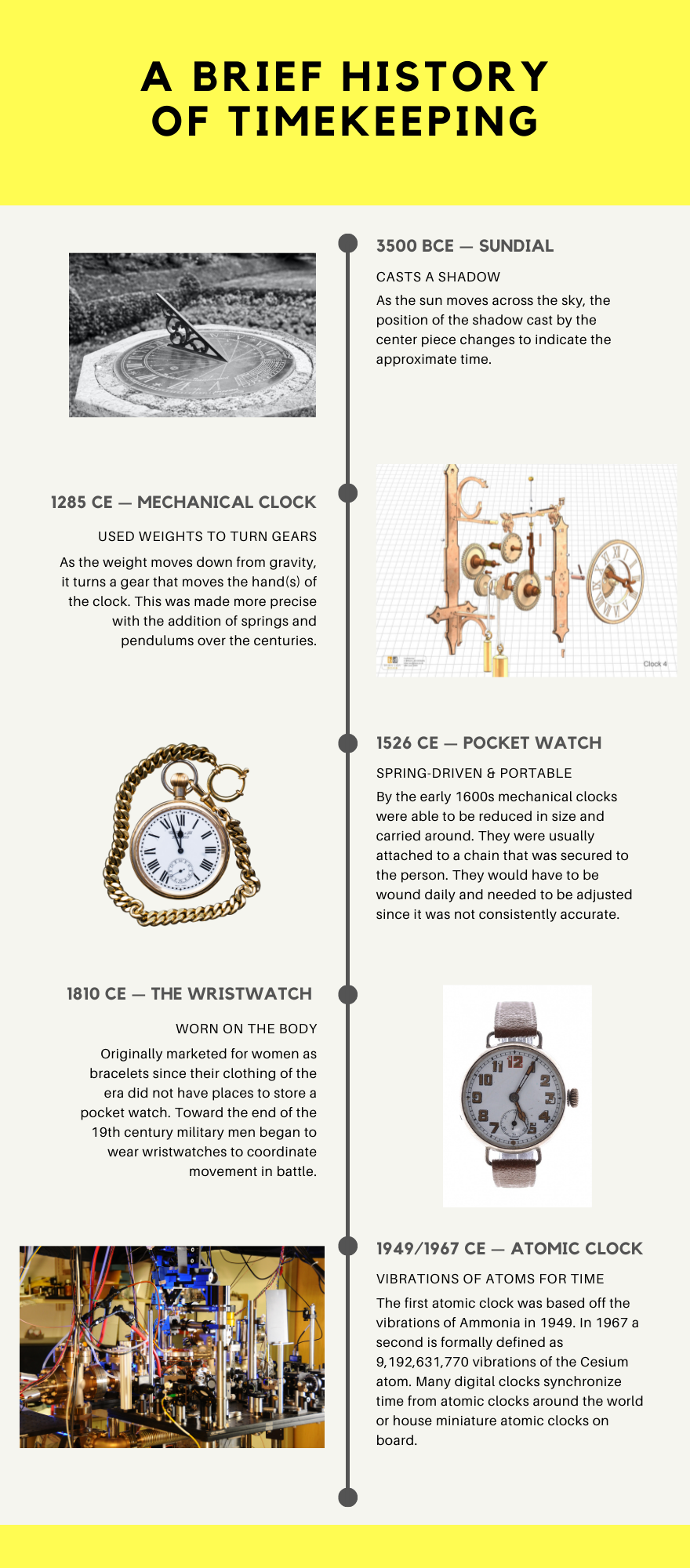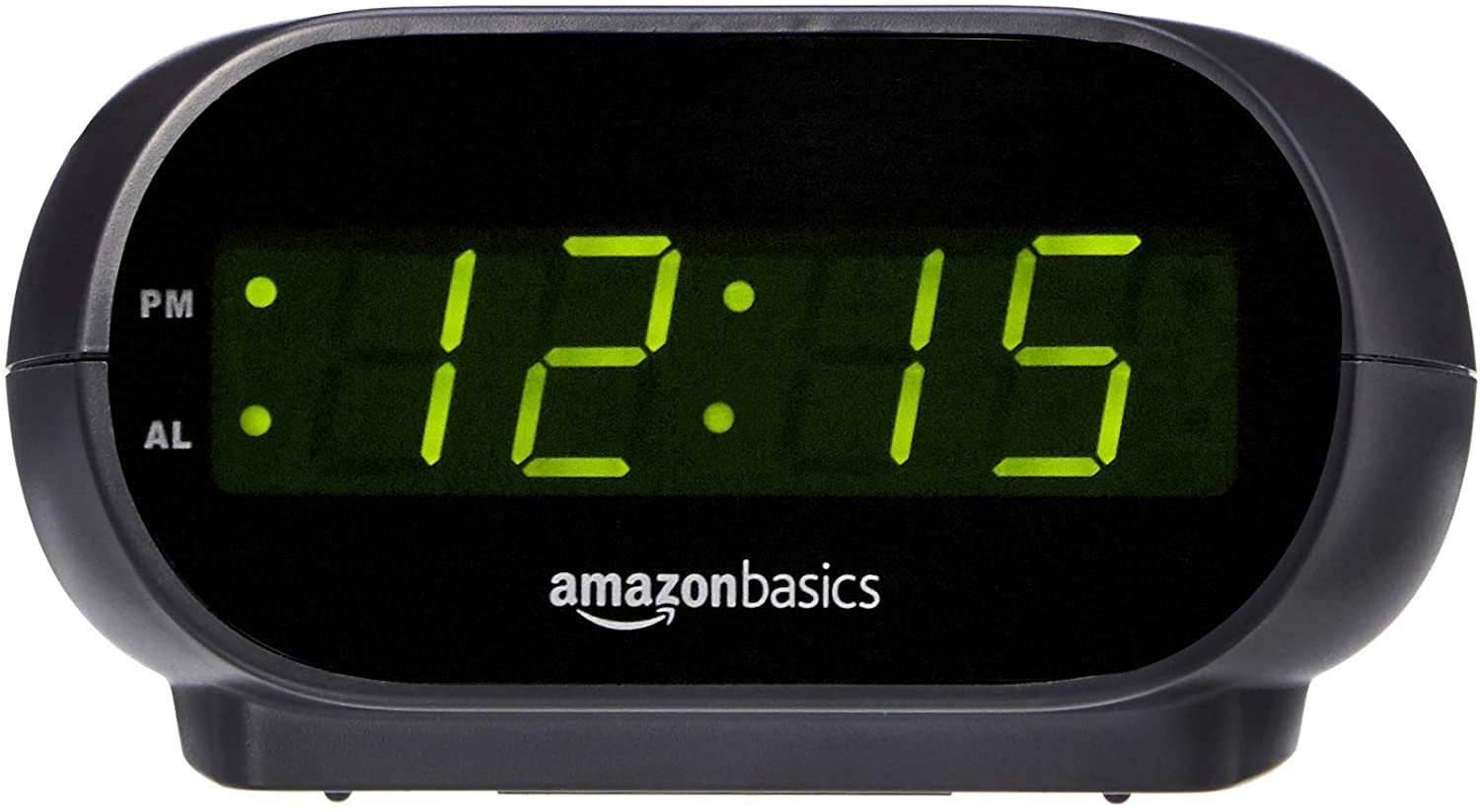Smartphone Clock app
Watch this iPhone Clock app tutorial to see what features it supports.
We often use the “clock” app on our smartphones without thinking too much about how technology changes the way we experience time. As you watch the video or look at the clock app on your own smartphone, consider the following questions:
What are the benefits of the clock app?
What are drawbacks of the clock app?
How does the clock app affect the flow of my life?
You can consider these same questions as we investigate other and older technologies of time.
Technologies of Time
Time casts a big presence in our lives. At school, time seems to dictate everything. A school year starts in Texas on August 21st at precisely 8:00am in Central Standard Time (CST) and the school year ends on May 27th at exactly 3:00pm (also in CST). When the bell rings to end the school day at 3pm in Texas, students in Los Angeles still have two hours left of school. In Jakarta, Indonesia it’s the middle of the night the following day. Humans invented calendars and units of time and we, in turn, often regulate our lives to the minute.
As time was increasingly standardized, humans created time zones to ensure the time where they lived aligned with when the sun was up. Yet, in places like China, which has one time zone for its entire country, citizens in Beijing see the sun rise at 5:45am when in Kashgar the sun rises at 8:30am. Much of our sense of time comes from our relationship to the sun, moon, and the circadian rhythm in our bodies. What happens when our standardization of time disconnects so much with the natural rhythm of nature? Humans have made a lot of decisions about how we should understand time, but we don’t often step back to consider: Do we control clocks or do clocks control us?
Before we can answer this question, we need to figure out, what is time? Merriam-Webster defines time as many different things: duration, leisure, occasion, age, lifetime, season, tempo, rhythm, turn and more. Who knew time was so complicated? The Greeks kept it simpler. They had two definitions for time:
Kairos is about the right moment for something to happen according to human experience (qualitative).
Chronos is about the measurement of time represented by a number (quantitative).
In school, kairos is when you’re hungry and want to eat lunch; chronos is the hour that lunch is served in the cafeteria. They don’t always match up. Time can seem to drag on forever in a class that a student does not enjoy but fly by in one they find engaging. Chronos does not change but kairos does.
Of course, both kairos and chronos are ideas that humans made up. Humans evolved so that their bodies align to roughly stay awake during the day and sleep at night. This circadian cycle, or rhythm, takes place over roughly 24 hours. If a human lives in a cave without natural sunlight or a clock they would quickly lose their grasp of a day with physical and mental maladies to follow. If the light of the sun and moon helps humans tell time, why did they invent technologies of time?
Some of the earliest efforts at marking time included sundials, water clocks, candles, and incense sticks. These early efforts were used to divide the day into different sections, limit how long speeches could last in courts, set lengths for religious practices, etc. In some instances, water clocks and candle clocks were fashioned to mark time for 24 hours since sundials were only useful when it was sunny.
However, monks of the 12th and 13th centuries sought more precise reminders for their daily prayers and invented the mechanical clock. From that point forward, mechanical clocks were used more and more. With the industrial revolution, time was increasingly used to determine schedules and manage workers… and later school children. Over time, more clocks showed up everywhere and the time we measured (chronos) seems to have dominated the time we feel (kairos). Even though we have the same time people have always had, it’s common to feel like we do not have enough time. Each of us might return to the question, do I control time or do clocks control me?
To continue to investigate technologies of time, you can review the sources below and complete one of the suggested activities.
Source 1: Timeline
2022, Ryan Smits (Civics of Technology contributor)
This timeline is not comprehensive but includes major developments in timekeeping and how people tell time.
Source 2: How Humans Tell Time Video,
2019, Explore Mode YouTube Channel
Source 3: National Watch and Clock Museum Exhibit
No date, National Watch and Clock Museum Exhibit as curated by National Google Arts & Culture
Source 4: Terror of Modern Time Video
2013, Douglas Rushkoff (media theorist)
Source 5: Geologist Loses Sense of Time in Cave Article
2017, Larry Getlen in the New York Post
Source 6: Critical Excerpt on Clocks
1992, Technopoly: The Surrender of Culture to Technology book by Neil Postman (media theorist)
“Technology shapes the way we look at the world and how we interact. For example, “to a man with a hammer, everything looks like a nail.. . . But such prejudices are not always apparent at the start of a technology's journey, which is why no one can safely conspire to be a winner in technological change. Who would have imagined, for example, whose interests and what world-view would be ultimately advanced by the invention of the mechanical clock? The clock had its origin in the Benedictine monasteries of the twelfth and thirteenth centuries [see image to the right]. The impetus [motivation] behind the invention was to provide a more or less precise regularity to the routines of the monasteries, which required, among other things, seven periods of devotion during the course of the day. The bells of the monastery were to be rung to signal the canonical [according to the bible] hours; the mechanical clock was the technology that could provide precision to these rituals of devotion. And indeed it did. But what the monks did not foresee [predict] was that the clock is a means not merely of keeping track of the hours but also of synchronizing and controlling the actions of men. And thus, by the middle of the fourteenth century, the clock had moved outside the walls of the monastery, and brought a new and precise regularity to the life of the workman and the merchant. "The mechanical clock," as Lewis Mumford wrote, "made possible the idea of regular production, regular working hours and a standardized product." In short, without the clock, capitalism would have been quite impossible. The paradox, the surprise, and the wonder are that the clock was invented by men who wanted to devote themselves more rigorously to God; it ended as the technology of greatest use to men who wished to devote themselves to the accumulation of money.” (Postman, 1992, pp. 14-15)
Source 7: Amazon and New Taylorism
2018, Richard Salame in Jacobin
While this article is in Jacobin, a left-leaning publication, it provides a useful comparison between tactics Amazon uses to monitor employee productivity with tactics from over 100 years ago. All of these examples point to answering how technologies of time have been used to control workers and how workers have resisted.
Activities
-
Experience Technologies of Time
Students will create a sun dial or water clock, use an hour glass, or use an analogue clock and compare those to digital smartphone clocks. -
Keep Time Diary
Students can either keep a diary for one day of how they use their time or make estimates about how long they do activities at school and compare that to the clock time.
-
Participate in Time Fast
The school, grade level, or class will “fast” from using clocks throughout a day and document their experiences. They will rely on kairos, not chronos. They will consider the benefits and drawbacks of each approach. If students cannot do this activtity at school then they can do so at home.
-
Ask Critical Questions
Students will critically inquire into their relationship with time by asking the five critical questions about modern clocks:
1. What does we give up for the benefits of clocks?
2. Who is harmed and who benefits from clocks?
3. What do clocks need?
4. What are the unintended or unexpected changes caused by clocks?
5. Why is it difficult to imagine our world without clocks?




